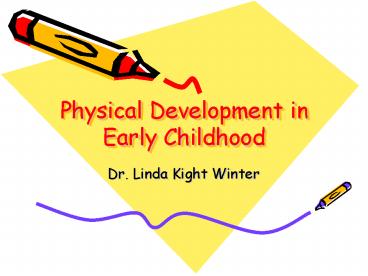Physical Development in Early Childhood - PowerPoint PPT Presentation
1 / 30
Title:
Physical Development in Early Childhood
Description:
Physical Development in Early Childhood Dr. Linda Kight Winter Age 5 walk stairs climb balance throw a ball ride bike Age 2 struggle to walk without falling over Age ... – PowerPoint PPT presentation
Number of Views:233
Avg rating:3.0/5.0
Title: Physical Development in Early Childhood
1
Physical Development in Early Childhood
- Dr. Linda Kight Winter
2
Age 5
- walk stairs
- climb
- balance
- throw a ball
- ride bike
3
Age 2
- struggle to walk without falling over
4
Age 3-5
- reach many milestones with increasing coordination
5
Developmental Milestones
- Tasks most children can perform at certain ages.
- Genetics and experience play a role in the ages
on the milestones.
6
Physical Growth in EC
- Leads away from
- unsteadiness of
- childhood
- center of gravity
- is high in toddlers
7
- Cephalocaudal
- (head to toe)
- and
- Proximodistal
- (near to far)
- growth
8
Physical Growth in EC
- torso grows longer, body lengthens
- muscles get stronger
- center of gravity shifts closer to belly button
9
Gross Motor Skills
- skills like running, jumping, climbing, and
throwing, that require the use of large muscle
groups in the arms and legs, as well as strength
and stamina
10
Developed through
- Running, walking, galloping, tiptoeing
- Throwing, catching
- Climbing, jumping, rock walls
- Balancing and Spinning
11
Activities that foster Gross Motor Development
- Follow the leader
- Simon Says
- Obstacle Courses
- Relay Races
12
Activities that foster Gross Motor Development
- Dancing
- Running Stepping Stones
- Bean Bags Balanced on Head
- Pretend to be
- Cars, Planes etc.
13
Rough and Tumble Play
- Not violent
- Builds Camaraderie
- Relieve Tension
- Uses several muscle
- groups at once
14
End of preschool/Beginning of Kindergarten
- Start, stop, and change directions while running
- Walk up and down stairs while alternating feet
- Balance while walking on a beam
- Hop on one foot ten or more times
- Use a swing independently
15
Fine Motor Development
- The coordination of small muscle groups in the
arms, hands, and fingers used to complete tasks
like drawing, zipping, snipping, tying, and
molding with clay
16
Activities that foster fine motor development
- Using toys with zippers, buttons, and buckles
- Stringing pasta on yarn
- Carving designs into clay
- Cutting pictures from magazines
- Singing songs involving finger play (Itsy Bitsy
Spider)
17
Lowenfelds Stages of Artistic Development
18
Scribbling
- 15 months to 4 years
- large zigzagging lines and non-descript shapes
about which they will tell stories
19
Preschematic
- Ages 3-7
- faces, protruding arms and legs, houses,
repetitive practice, objects, people floating in
space
20
5 year old
21
(No Transcript)
22
5 year old
23
Schematic
- Ages 6-10
- people attached to ground
- Closer proportion to real world
- blue sky attached to top of page
24
(No Transcript)
25
(No Transcript)
26
Realism
- Ages 9-11
- Details, style, depth and perception appear
27
(No Transcript)
28
Fine Motor Milestones bythe end of preschool
- Hold a pencil
- Write letters
- Draw pictures
- Cut with scissors
- String beads
- Button large buttons
- Zip a zipper
- Eat with fork and spoon
29
Other factors affecting physical development
- Prenatal and medical care
- Nutrition
- Sleep
- Environment
- Genetics
- Disabilities
- Poverty
30
Links
- http//www.med.umich.edu/1Libr/yourchild/devmile.h
tm - http//www.kidsgrowth.com/stages/guide/index.cfm
http//www.pbs.org/wholechild/abc/index.html

